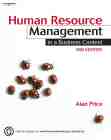Bestselling Books
|
Bestselling Books |
|
| US Bestsellers UK Bestsellers France - Meilleurs Ventes Canada Bestsellers Germany Bestsellers |
 Hooked on books? BestBooks.biz features book-related articles, book extracts and book selections from the best books - past and present. 404 Not Found/RequestFormattedAds.aspx was not found on this server.Resin-3.0.18 (built Fri, 24 Feb 2006 02:47:03 PST)  Human Resources Management: A Critical Text, 3eJohn Storey (editor)Designed to meet the needs of advanced management students on a variety of courses, the international team of expert contributors provides an in-depth, authoritative, critical and original account of contemporary HRM More information and prices from: Amazon.com - US dollars Amazon.ca - Canadian dollars Amazon.co.uk - British pounds Amazon.de - Euros Amazon.fr - Euros |
High Performance Management Systems - Part 2Adapted from Human Resource Management in a Business Context, 3rd edition (2007) Pfeffer (1998) acknowledges that building a high-commitment organization is not easy and that CEOs are often too busy or distracted to focus on the people. However, he advocates the following as key elements of high-commitment management: * Building trust so that everyone in the organization can share knowledge.
In the public sector, the US Department of Labor (1998) sees high performance revolving around three main principles: * An organizational focus on achieving customer satisfaction.
So what are the key operating practices of such a high performance system? According to the Department of Labor they are: Leadership and support from top levels of management - the most critical element of the process. Top managers must develop a climate of trust where risk-taking and innovation are encouraged and rewarded. This means that workers and managers must together develop a shared vision of where they want the organization to go. It also means that there must be tolerance shown towards the inevitable setbacks and mistakes along the way. And managers must be open to suggestions and requests from workers for the removal of barriers to good customer service. This implies a considerable change from the top-down 'I'm in charge and all mistakes will be punished' attitude prevalent among higher management. Strategic planning - mapping out how the organization will achieve its strategic objectives. But such a plan must be constantly reviewed. Ongoing commitment to training and development for all employees - not just top-middle ranking staff where organizations concentrate their funds too often. Neglecting the training and development of customer-facing staff is potentially damaging in terms of its consequences. Somehow, an organization must also withstand the pressure from budget-cutters to reduce training levels as an easy (and stupid) way of reducing costs. A focus on the customer - not just meeting customer expectations but exceeding them, and devoting considerable energy into finding out the changing expectations of customers through surveys, feedback and other mechanisms. This applies to internal as well as external customers. A focus on quality - advocating a TQM approach of dealing with problems as they occur and providing a perfect end product. This differs from the traditional 'inspect, reject or deal with complaint' approach. Empowering frontline employees and an emphasis on teamwork - the buzzwords: empowerment, employee involvement and teamwork come in here. Harness the intelligence and energies of your employees 'the potential for successful and quality results is virtually limitless." Develop measures of progress - data collection mechanisms to ensure that customers are receiving reliable and satisfactory service and that internal processes are functioning properly. The US Department of Labor (1998) identifies problems with the high-performance approach in respect of government employees (problems that apply in most cases to all non-manufacturing sectors): 1. High performance is conceptually easier to understand in a manufacturing than a service context. 2. Competitivenes is a main motivating factor in the private sector, but scarcely a consideration in the public sector. 'Government is mission-driven rather than profit-driven'. 3. 'Government is viewed by many as the archetypal, inflexible, hierarchical structure, and, therefore, incapable of change.' 4. The traditional measurable outcomes of the manufacturing sector - reduced production costs, improved market share, increased profitability - are not so easy to measure in the service sector. Introduction to HRM on HRM Guide This article is based on Human Resource Management in a Business Context by Alan Price (3rd edition, 2007) . |
 in a Business Context by Alan Price
|
|
|
|
|
|
|
|
|
| Copyright © 2000-20l7 Alan Price and BestBooks.biz contributors. All rights reserved. |